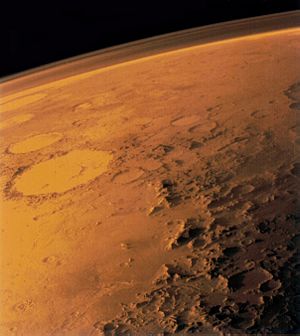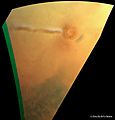Atmosphere of Mars facts for kids
The atmosphere of Mars is the layer of gases that surrounds the planet Mars. It is mostly made up of carbon dioxide. Mars' atmosphere is much thinner than Earth's. The air pressure on Mars is very low, so low that water would boil at the normal temperature of the human body (about 37 °C or 98.6 °F).
The Martian atmosphere is about 96% carbon dioxide. It also has small amounts of argon (1.9%), nitrogen (1.9%), and tiny traces of oxygen, carbon monoxide, water, and methane. Scientists found methane in 2003. This discovery made them wonder if there could be life on Mars. However, methane can also come from geological processes, volcanoes, or hot springs.
The atmosphere on Mars is quite dusty. This dust makes the Martian sky look light brown or orange-red from the surface. NASA data shows that the dust particles are very tiny. Huge dust storms that cover the whole planet happen about every 5.5 Earth years. These storms can be dangerous for Mars rovers. Scientists are still trying to fully understand how these big dust storms form. Some think they might be linked to the gravity of Mars' two moons, similar to how tides are created on Earth.
In 2015, NASA found an aurora on Mars that scientists don't fully understand. They also saw an unexplained dust cloud in the atmosphere.
Contents
Why Mars' Atmosphere is Thin
Long ago, there was a lot of liquid water on Mars. This means Mars must have had a much thicker atmosphere. Many studies show that Mars' atmosphere has become thinner over time. This happened because of solar winds. On Earth, our magnetic field protects us from most of these winds. Mars used to have a magnetic field too. But its core cooled down, and it lost its magnetic field. Without this protection, the solar winds slowly stripped away Mars' atmosphere.
Temperature on Mars
The atmosphere of Mars is much colder than Earth's. Mars is farther from the Sun, so it gets less heat. Its average temperature is about -63 °C (-81 °F). This is similar to the temperature in inland Antarctica on Earth.
Even though Mars' atmosphere has a lot of carbon dioxide, its greenhouse effect is very weak. The greenhouse effect on Mars only warms the planet by about 5 °C (9 °F). On Earth, it warms us by about 33 °C (59 °F). This is because Mars' atmosphere is so thin. The small amount of carbon dioxide means it traps less heat. Temperatures on Mars can range from -75 °C (-103 °F) to almost 0 °C (32 °F) near the surface in some areas. The upper atmosphere is also much colder than Earth's. This is because Mars does not have an ozone layer.
Using Mars' Atmosphere for Humans
Scientists are looking into ways to use the Martian atmosphere. They think future human missions to Mars could use the carbon dioxide from the atmosphere. This carbon dioxide could be turned into methane. Methane could then be used as rocket fuel for the journey back to Earth.
In 2021, NASA's Perseverance rover successfully made oxygen on Mars. This process is complicated and takes a lot of time to produce only a small amount of oxygen. But it shows that making breathable air on Mars is possible.
Images for kids
-
Martian sunset seen by the Spirit rover at Gusev crater (May, 2005).
-
Martian sunset seen by Pathfinder at Ares Vallis (July, 1997).
-
Argon isotope ratios show how Mars' atmosphere has been lost over time.
-
Water-ice clouds near the Arsia Mons volcano.
-
A Dust devil on Mars, seen by the Curiosity rover (August 9, 2020).
-
Mars Pathfinder – Martian sky with water ice clouds.
See also
 In Spanish: Atmósfera de Marte para niños
In Spanish: Atmósfera de Marte para niños













